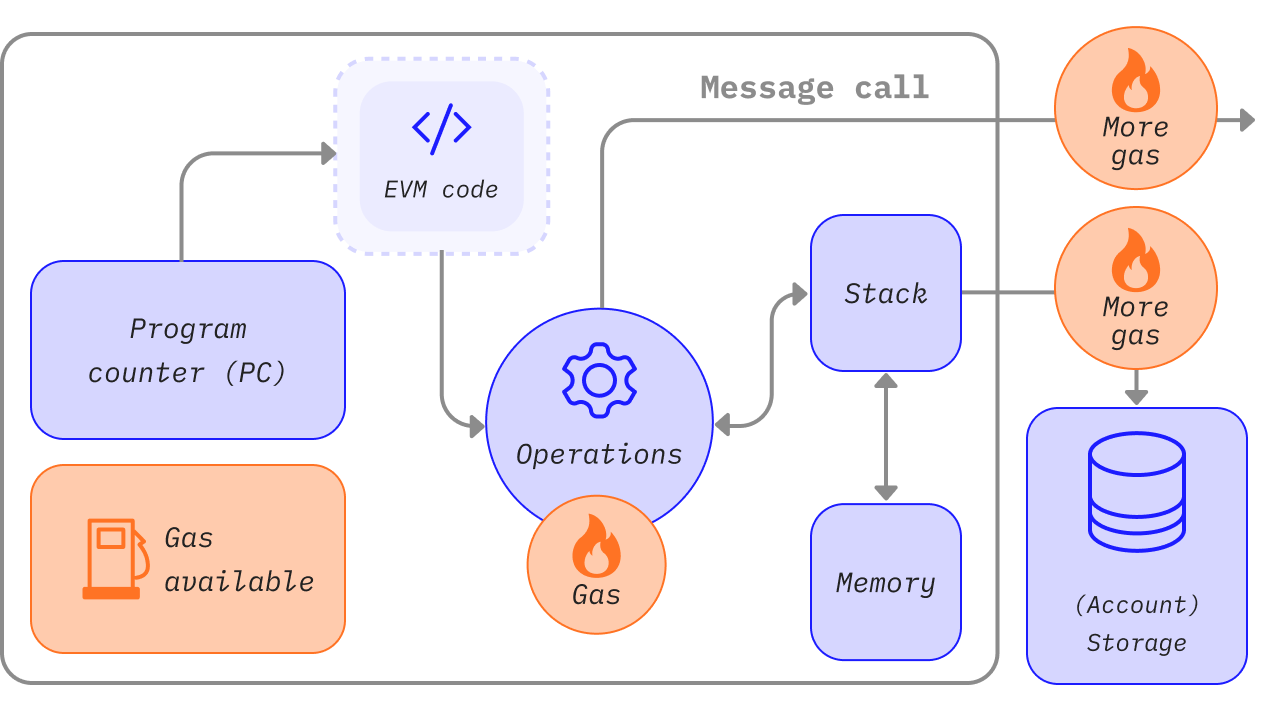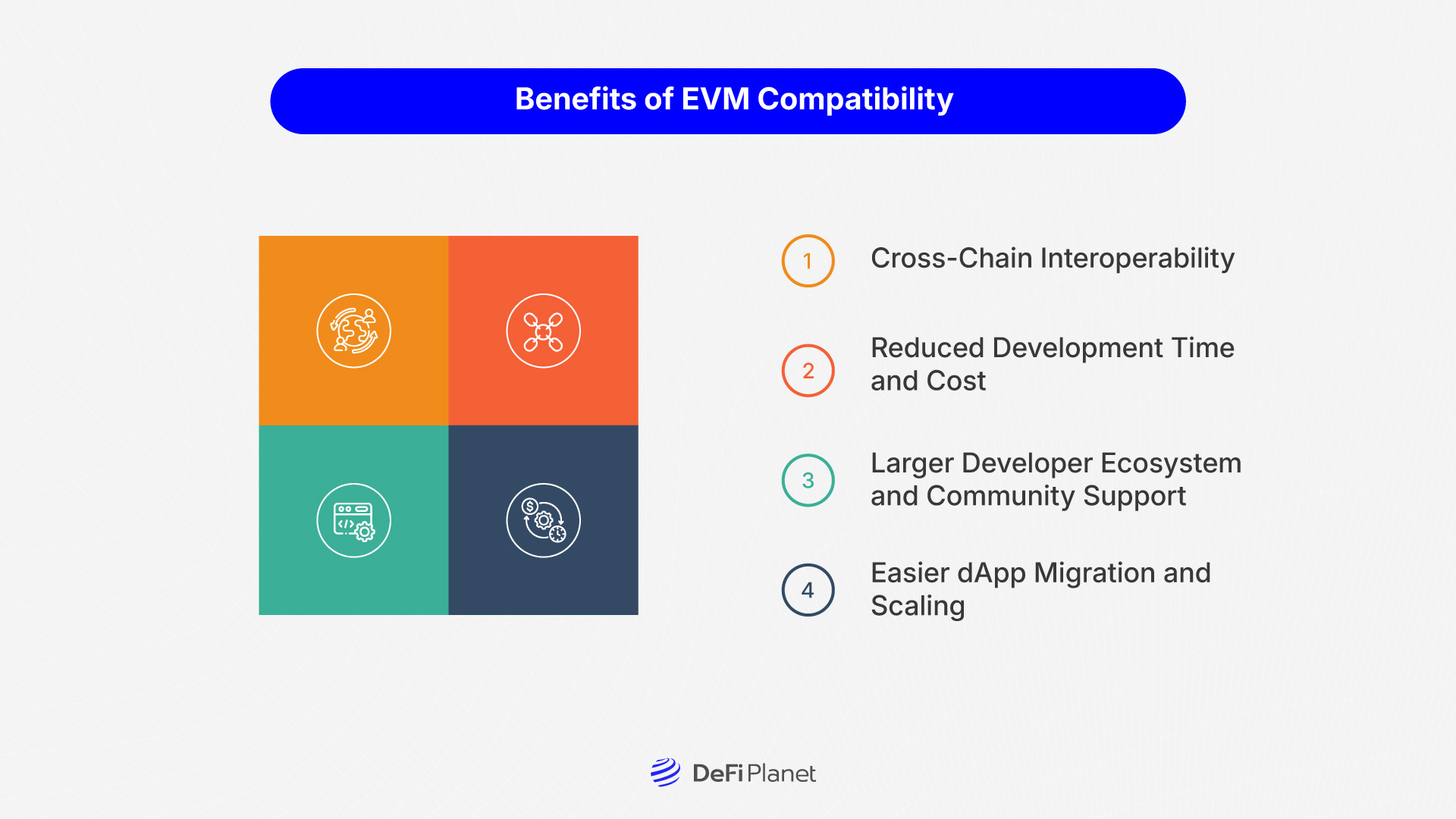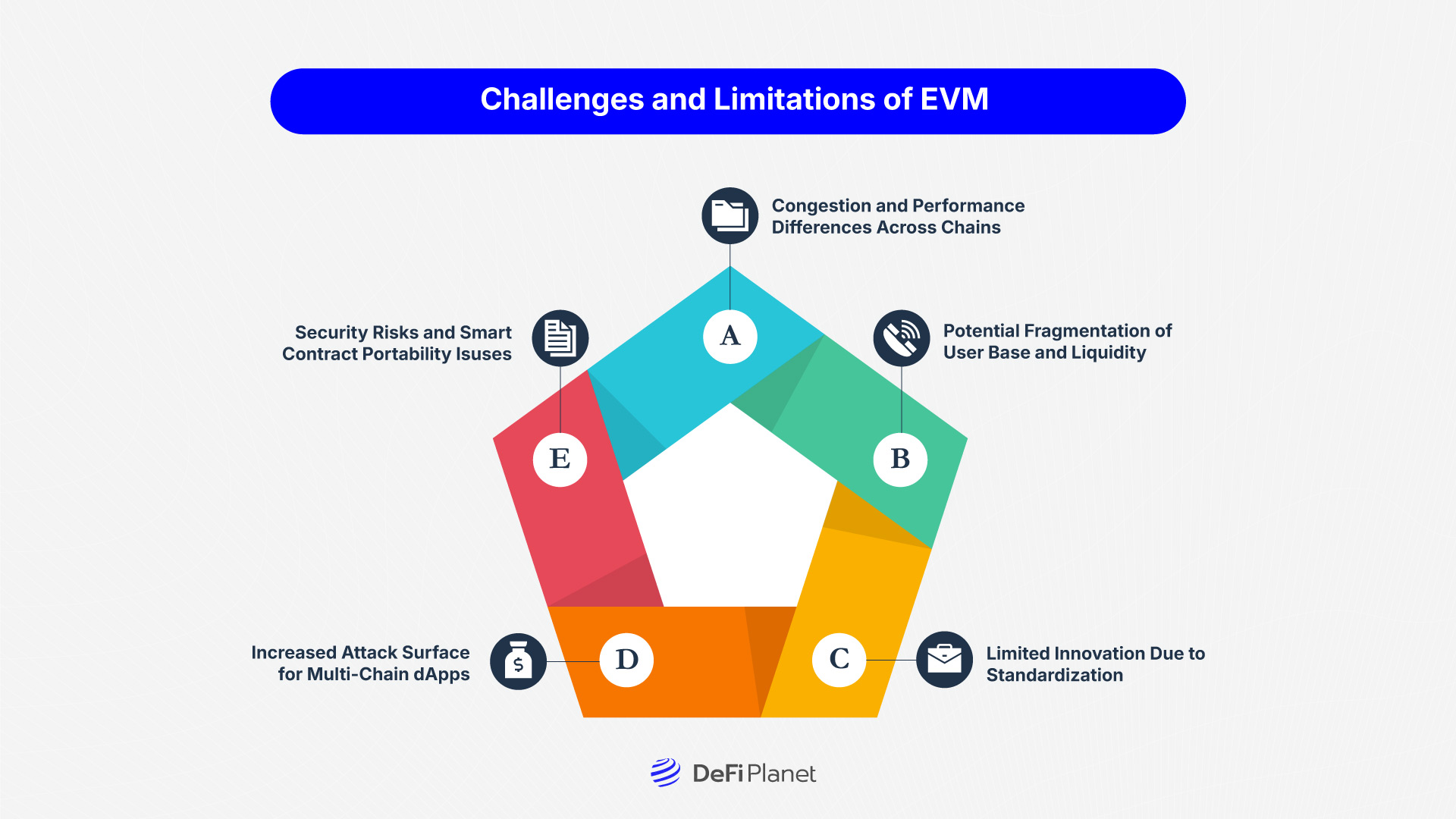Because the blockchain house continues to increase in 2025, we’re seeing a transparent shift towards a multichain future, the place customers, property, and functions transfer fluidly throughout totally different networks. On this evolving panorama, one idea retains arising: EVM compatibility.
EVM-compatible chains enable builders to construct and deploy dApps utilizing the identical instruments and codebases as they might on Ethereum. This compatibility has develop into a serious driver of progress, enabling quicker improvement, higher interoperability, and broader adoption.
Understanding what Ethereum Digital Machine compatibility means, and why so many chains are embracing it, is essential to creating sense of in the present day’s fragmented but interconnected blockchain world. Whether or not you’re a developer, investor, or person, figuring out how EVM-compatible blockchains work will help you notice alternatives and navigate the ecosystem extra successfully.
What Is the Ethereum Digital Machine (EVM)?
The EVM is the core expertise that powers Ethereum’s means to run good contracts. It features as a decentralized computing setting that executes code precisely as written, throughout a world community of Ethereum nodes.

At its core, the EVM acts like a common processor for the Ethereum blockchain. When a wise contract is deployed or a transaction is triggered, it’s the EVM that interprets and executes the underlying code. Each node within the Ethereum community runs its personal occasion of the EVM, making certain all transactions are verified and agreed upon in a trustless and deterministic approach.
The Ethereum Digital Machine is essential to Ethereum’s performance as a result of it allows the platform to transcend easy peer-to-peer transfers. It permits builders to create advanced functions, starting from DeFi platforms to NFT marketplaces, utilizing programmable, self-executing contracts.
Consider the EVM because the engine behind all Ethereum-based dApps. It offers the foundations and setting through which contracts are securely executed, whatever the {hardware} or location of the node working them. With out the EVM, Ethereum can be simply one other cryptocurrency. With it, Ethereum turns into a programmable blockchain able to supporting an unlimited and rising ecosystem of decentralized functions.
What Makes a Blockchain EVM-Suitable?
A blockchain is taken into account EVM-compatible when it might interpret and execute Ethereum Digital Machine bytecode, the low-level machine code that the Ethereum Digital Machine understands.
This implies good contracts compiled for Ethereum can run on these chains without having to be rewritten. EVM-compatible chains replicate the core logic of Ethereum’s digital machine in order that contract behaviour stays constant throughout networks.
Assist for Solidity and Ethereum-Based mostly Developer Instruments
Past bytecode compatibility, EVM-compatible blockchains assist Solidity, Ethereum’s major good contract programming language. In addition they combine with acquainted Ethereum improvement instruments like Remix, Hardhat, Truffle, MetaMask, and Web3.js.
This makes it straightforward for builders to construct, check, and deploy dApps utilizing the identical workflows they already know, with out studying a brand new programming language or setting.
Examples of EVM-Suitable Chains
A number of outstanding blockchains have adopted EVM compatibility to draw builders and customers from the Ethereum ecosystem. These embrace:
BNB Sensible Chain (BSC) – Presents quicker block occasions and decrease charges whereas supporting Ethereum-compatible good contracts.
Avalanche C-Chain – A part of Avalanche’s multi-chain structure designed particularly to run Ethereum-compatible dApps.
Polygon – A Layer 2 scaling answer for Ethereum that helps Ethereum Digital Machine-compatible good contracts with quicker and cheaper transactions.
Optimism and Arbitrum – Main Ethereum Layer 2 rollups that execute good contracts off-chain and publish the outcomes to Ethereum, all whereas sustaining full EVM compatibility.
These chains decrease the entry barrier for builders and foster cross-chain interoperability by sustaining a shared programming customary centered across the EVM.
Advantages of EVM Compatibility
In a quickly increasing multichain ecosystem, Ethereum Digital Machine compatibility presents highly effective benefits for builders, customers, and blockchain networks alike:

Cross-Chain Interoperability
EVM compatibility allows dApps to function throughout a number of blockchains with minimal modifications to their code. This fosters cross-chain interoperability, the place property and good contracts can work together seamlessly throughout networks like Ethereum, Polygon, and Avalanche. It additionally makes it simpler for builders to construct apps that work with bridges and Layer 2 options, increasing their attain whereas sustaining Ethereum-level logic.
Lowered Improvement Time and Value
As a result of EVM-compatible chains assist Solidity and Ethereum tooling, builders can reuse present code, frameworks, and deployment processes.
This considerably reduces improvement time and prices, eliminating the necessity to study new programming languages or construct from scratch when launching on a brand new chain.
Bigger Developer Ecosystem and Group Assist
Ethereum Digital Machine compatibility connects builders to Ethereum’s large open-source ecosystem. This implies higher entry to group data, pre-built libraries, templates, and documentation.
Builders can discover options quicker, collaborate extra simply, and faucet into a big pool of contributors, accelerating innovation and lowering friction within the improvement lifecycle.
Simpler dApp Migration and Scaling
For tasks trying to scale or keep away from Ethereum’s congestion and excessive gasoline charges, EVM-compatible chains supply an easy path. Builders can migrate their dApps to quicker or cheaper networks like Arbitrum or BNB Sensible Chain with out rebuilding core logic.
This makes EVM compatibility a key enabler of scalability, flexibility, and resilience in in the present day’s multichain setting.
Challenges and Limitations
Whereas Ethereum Digital Machine compatibility has unlocked immense progress and interoperability throughout blockchains, it additionally comes with trade-offs. These challenges vary from technical limitations to ecosystem-wide penalties that builders and customers should think about when constructing or interacting with EVM-compatible networks.

Safety Dangers and Sensible Contract Portability Points
Porting good contracts from Ethereum to different EVM-compatible chains isn’t all the time seamless. Variations in consensus mechanisms, block occasions, or charge constructions can introduce surprising bugs or vulnerabilities. A contract that’s safe on Ethereum would possibly behave unpredictably on one other chain if not rigorously audited in its new setting.
Congestion and Efficiency Variations Throughout Chains
EVM compatibility doesn’t assure similar efficiency. Some networks might endure from congestion, slower finality, or inconsistent gasoline charge constructions relying on their infrastructure. Builders should account for these variances, particularly when concentrating on customers throughout a number of Ethereum Digital Machine chains.
Potential Fragmentation of Consumer Base and Liquidity
With dApps deployed throughout a number of EVM-compatible networks, person exercise and liquidity can develop into fragmented. This splintering makes it more durable to construct sturdy community results, impacts DeFi protocols that depend upon pooled capital, and complicates governance and group coordination.
Restricted Innovation Attributable to Standardization
Whereas Ethereum Digital Machine compatibility simplifies improvement, it might additionally restrict innovation. Chains might really feel compelled to evolve to Ethereum’s design decisions, even when various architectures would possibly higher go well with their wants. This concentrate on compatibility can decelerate the adoption of novel digital machines, programming languages, or execution fashions.
Elevated Assault Floor for Multi-Chain dApps
As dApps increase to extra EVM-compatible chains, they need to handle a number of deployment environments, growing their general assault floor. Every new chain introduces its personal dangers, whether or not by way of totally different validators, bridges, or infrastructure dependencies, creating extra entry factors for potential exploits.
Why EVM Compatibility Issues for the Way forward for Web3
Because the Web3 ecosystem evolves, the demand for seamless interplay between blockchains is reshaping how decentralized functions are constructed, used, and scaled.
EVM compatibility has emerged as a key enabler of this imaginative and prescient, serving to unify the fragmented panorama and decrease the limitations to mass adoption.
The Push Towards Multichain and Cross-Chain Ecosystems
The way forward for Web3 isn’t restricted to a single blockchain. As an alternative, it’s changing into a multichain world, the place customers work together with a number of networks primarily based on their wants, whether or not it’s pace, cost-efficiency, privateness, or scalability.
Ethereum Digital Machine compatibility helps this shift by permitting dApps and builders to function throughout a number of chains utilizing acquainted instruments and codebases. This flexibility provides customers extra selection and resilience whereas serving to builders attain broader audiences.
The Position of EVM Compatibility in Scaling dApp Adoption
For decentralized functions to scale, they should be accessible, quick, and cheap to make use of. EVM-compatible blockchains enable dApps initially constructed on Ethereum to launch on quicker, lower-cost blockchains like Optimism, Arbitrum, or Avalanche C-Chain, with out vital redevelopment.
This makes it simpler to serve world customers, particularly in areas the place excessive gasoline charges are a barrier. EVM compatibility additionally accelerates time-to-market for builders, boosting innovation and ecosystem progress.
How It Contributes to Broader Blockchain Interoperability
True blockchain interoperability means property, contracts, and customers can transfer freely throughout networks. EVM compatibility brings us nearer to that actuality by offering a typical technical customary throughout chains.
This simplifies integration with bridges, wallets, and tooling, enabling smoother interactions between protocols. As extra chains undertake Ethereum Digital Machine compatibility, they develop into a part of a loosely unified community, serving to fulfil the Web3 imaginative and prescient of an open, interconnected, and user-controlled web.
Closing ideas
EVM-compatible blockchains are on the coronary heart of Web3’s evolution, shaping the subsequent era of decentralized functions by way of enhanced accessibility, scalability, and interoperability. By supporting Ethereum’s extensively adopted requirements, these blockchains empower builders to construct and deploy dApps quicker, with fewer limitations and broader attain.
This compatibility doesn’t simply streamline improvement; it helps unify an more and more fragmented ecosystem. Because the demand for cross-chain interoperability and user-friendly Web3 experiences grows, Ethereum Digital Machine-compatible networks will proceed to play an important function in making blockchain functions extra sensible and accessible for the world.
For builders, this can be a name to embrace the multichain future, to suppose past a single community and construct with interoperability in thoughts. For customers, it’s a chance to discover a richer, extra versatile Web3 expertise, the place switching chains doesn’t imply beginning over. The longer term isn’t simply Ethereum, it’s each chain that speaks its language.
Disclaimer: This text is meant solely for informational functions and shouldn’t be thought-about buying and selling or funding recommendation. Nothing herein must be construed as monetary, authorized, or tax recommendation. Buying and selling or investing in cryptocurrencies carries a substantial threat of monetary loss. All the time conduct due diligence.
If you need to learn extra articles like this, go to DeFi Planet and observe us on Twitter, LinkedIn, Fb, Instagram, and CoinMarketCap Group.
Take management of your crypto portfolio with MARKETS PRO, DeFi Planet’s suite of analytics instruments.”
The publish What Are EVM-Suitable Blockchains? appeared first on DeFi Planet.








